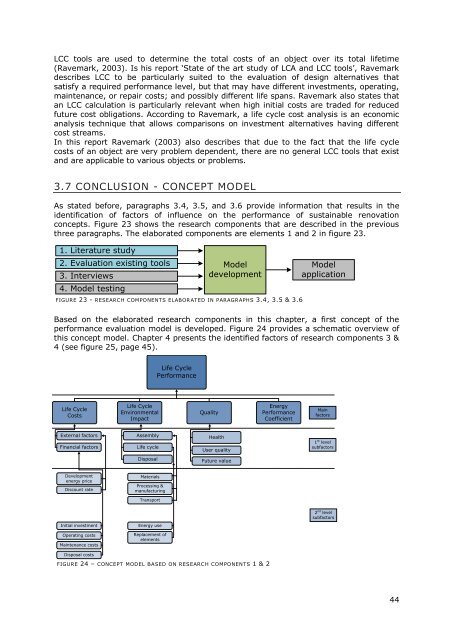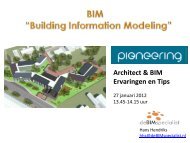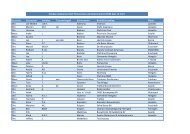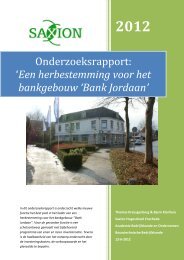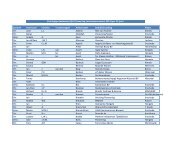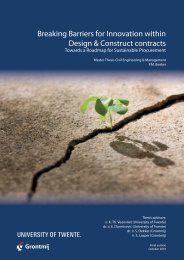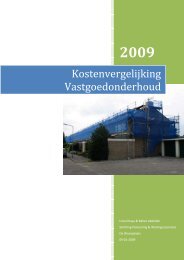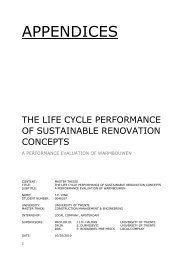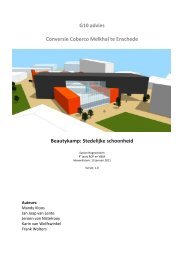the life cycle performance of sustainable renovation concepts
the life cycle performance of sustainable renovation concepts
the life cycle performance of sustainable renovation concepts
- No tags were found...
You also want an ePaper? Increase the reach of your titles
YUMPU automatically turns print PDFs into web optimized ePapers that Google loves.
LCC tools are used to determine <strong>the</strong> total costs <strong>of</strong> an object over its total <strong>life</strong>time(Ravemark, 2003). Is his report „State <strong>of</strong> <strong>the</strong> art study <strong>of</strong> LCA and LCC tools‟, Ravemarkdescribes LCC to be particularly suited to <strong>the</strong> evaluation <strong>of</strong> design alternatives thatsatisfy a required <strong>performance</strong> level, but that may have different investments, operating,maintenance, or repair costs; and possibly different <strong>life</strong> spans. Ravemark also states thatan LCC calculation is particularly relevant when high initial costs are traded for reducedfuture cost obligations. According to Ravemark, a <strong>life</strong> <strong>cycle</strong> cost analysis is an economicanalysis technique that allows comparisons on investment alternatives having differentcost streams.In this report Ravemark (2003) also describes that due to <strong>the</strong> fact that <strong>the</strong> <strong>life</strong> <strong>cycle</strong>costs <strong>of</strong> an object are very problem dependent, <strong>the</strong>re are no general LCC tools that existand are applicable to various objects or problems.3.7 CONCLUSION - CONCEPT MODELAs stated before, paragraphs 3.4, 3.5, and 3.6 provide information that results in <strong>the</strong>identification <strong>of</strong> factors <strong>of</strong> influence on <strong>the</strong> <strong>performance</strong> <strong>of</strong> <strong>sustainable</strong> <strong>renovation</strong><strong>concepts</strong>. Figure 23 shows <strong>the</strong> research components that are described in <strong>the</strong> previousthree paragraphs. The elaborated components are elements 1 and 2 in figure 23.1. Literature study2. Evaluation existing tools3. Interviews4. Model testingModeldevelopmentFIGURE 23 - RESEARCH COMPONENTS ELABOR ATED IN PARAGRAPHS 3.4, 3.5 & 3.6ModelapplicationBased on <strong>the</strong> elaborated research components in this chapter, a first concept <strong>of</strong> <strong>the</strong><strong>performance</strong> evaluation model is developed. Figure 24 provides a schematic overview <strong>of</strong>this concept model. Chapter 4 presents <strong>the</strong> identified factors <strong>of</strong> research components 3 &4 (see figure 25, page 45).Life CyclePerformanceLife CycleCostsLife CycleEnvironmentalImpactQualityEnergyPerformanceCoefficientMainfactorsExternal factorsFinancial factorsAssemblyLife <strong>cycle</strong>HealthUser quality1 st levelsubfactorsDisposalFuture valueDevelopmentenergy priceDiscount rateMaterialsProcessing &manufacturingTransport2 nd levelsubfactorsInitial investmentEnergy useOperating costsMaintenance costsReplacement <strong>of</strong>elementsDisposal costsFIGURE 24 – CONCEPT MODEL BASED ON RESEARCH COMPONENTS 1 & 244


